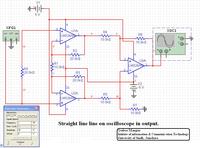Mangrio
Newbie level 2
- Joined
- May 26, 2010
- Messages
- 2
- Helped
- 0
- Reputation
- 0
- Reaction score
- 0
- Trophy points
- 1,281
- Location
- Hyderabad, Sindh
- Activity points
- 1,295
Re: help needed
will anyone help me to design a Instrumentation amplifier using LM324,
how to design the schematically on EWB and what input should be given and what resistor combination to be use here.
Instrumentation amplifier is a differential amplifier so, it takes different input..plz also explain this too
I have tried this one by getting help from some sites.

Added after 18 minutes:
Schematic diagram in high resolution...
will anyone help me to design a Instrumentation amplifier using LM324,
how to design the schematically on EWB and what input should be given and what resistor combination to be use here.
Instrumentation amplifier is a differential amplifier so, it takes different input..plz also explain this too
I have tried this one by getting help from some sites.

Added after 18 minutes:
Schematic diagram in high resolution...